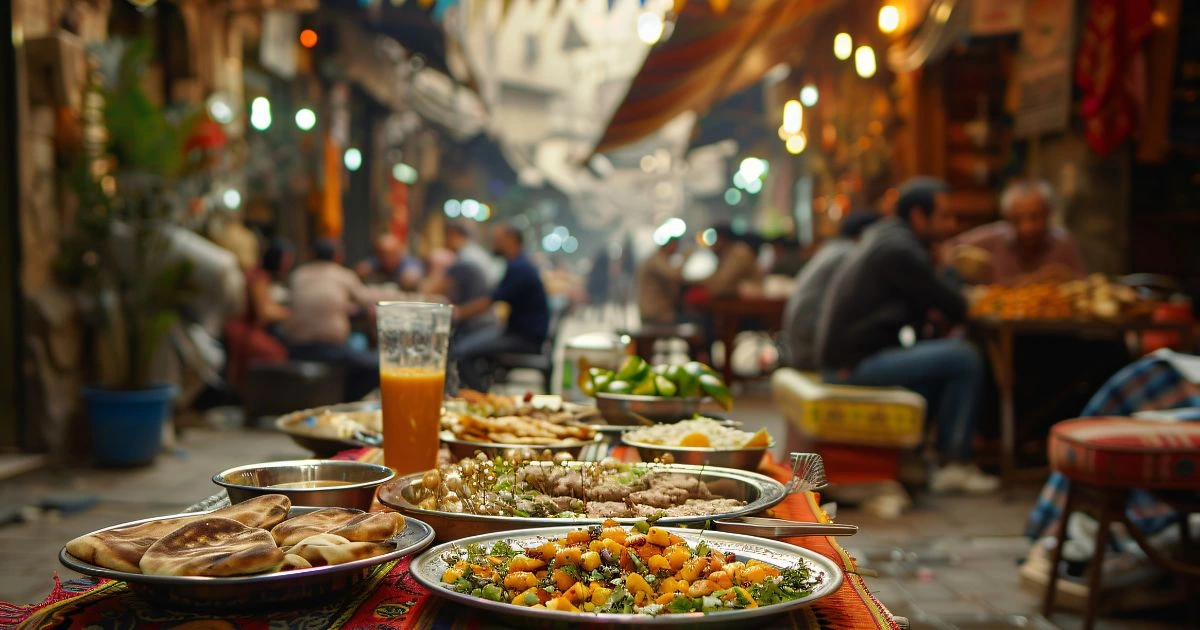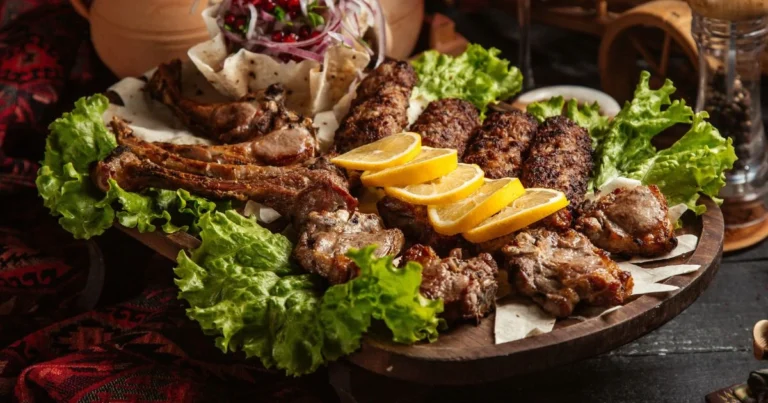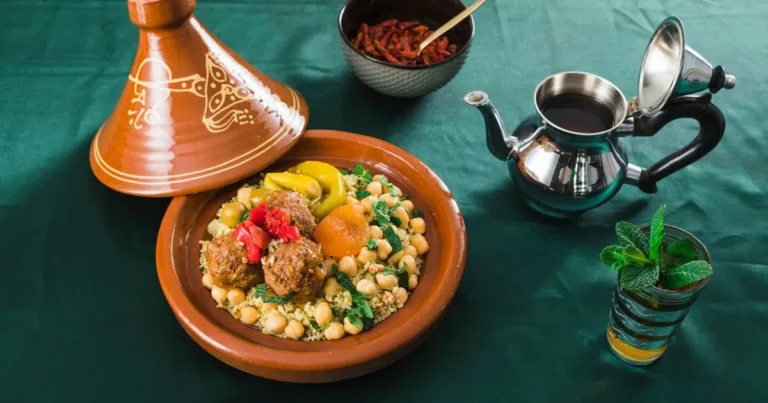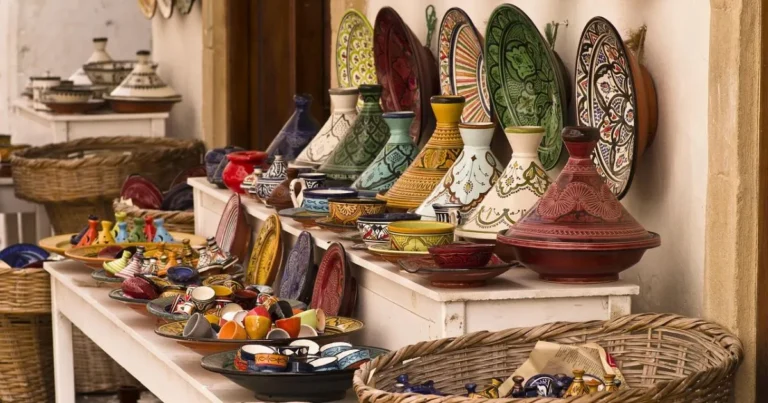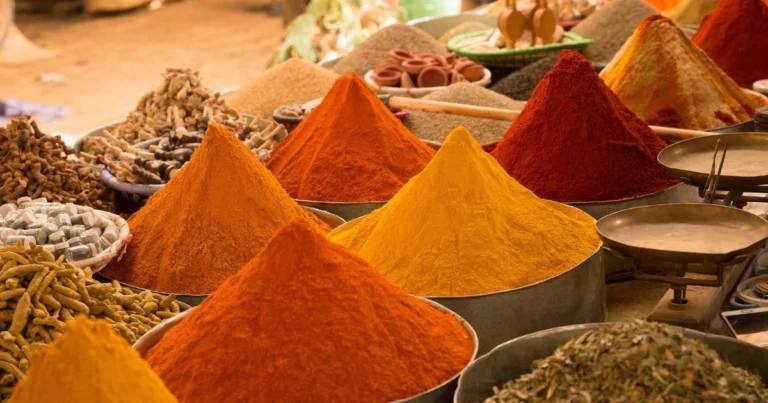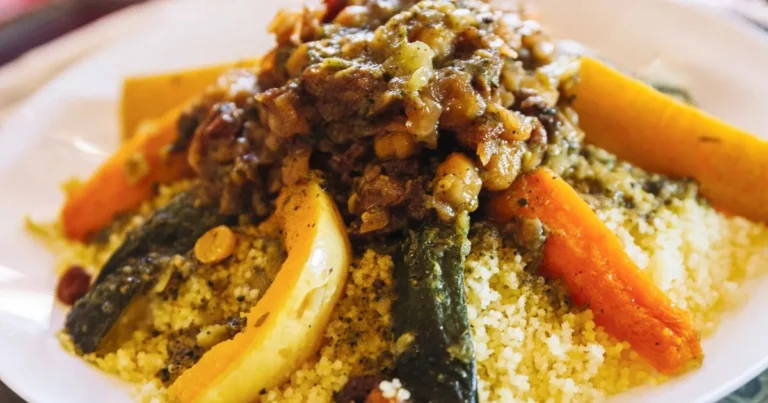The Ultimate Morocco Food Tour: A Regional Culinary Journey Through Imperial Cities and Desert Oases
Table of Contents
Embarking on a Morocco food tour is like opening a treasure chest of flavors that have been refined over centuries. From the bustling souks of Marrakech to the blue-painted streets of Chefchaouen, each region offers a distinctive culinary identity that reflects its unique history, geography, and cultural influences. While many travelers focus on Morocco’s stunning architecture and landscapes, the country’s Moroccan regional cuisine tells an equally compelling story through aromatic tagines, hand-rolled couscous, and spice blends that have been passed down through generations.
Morocco’s culinary richness originates from its strategic location at the intersection of Africa, Europe, and the Middle East. Berber traditions form the foundation, enriched by Arab influences, French colonial touches, and Jewish heritage. This rich tapestry means that a tagine in Marrakech tastes distinctly different from one prepared in the coastal city of Tangier or the mountain town of Chefchaouen. Understanding these regional variations transforms a simple meal into a cultural exploration, making every bite a discovery of local traditions, ingredients, and cooking techniques that define each destination.
Marrakech: The Red City’s Culinary Heart
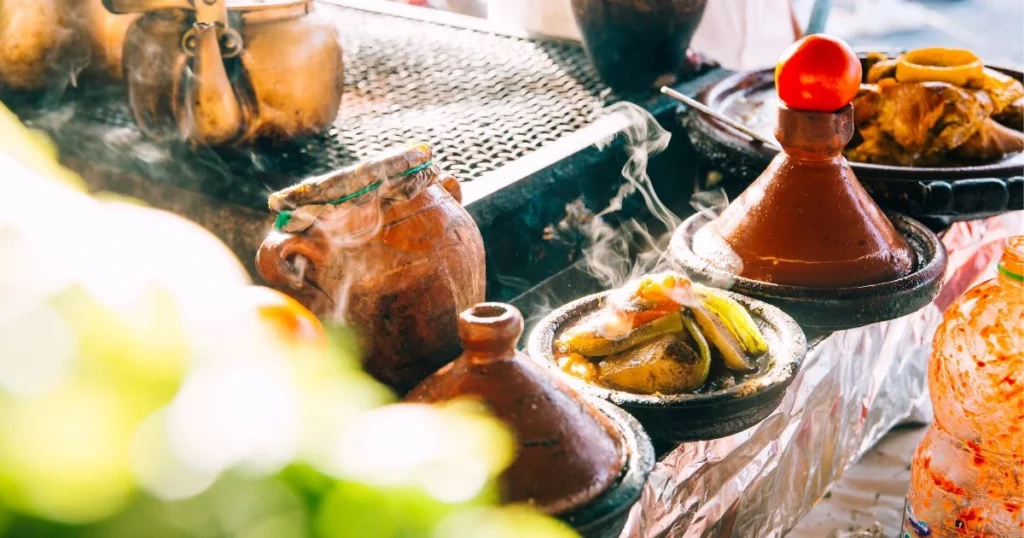
Marrakech serves as the gateway to Moroccan cuisine for many travelers, and for good reason. The city’s Moroccan restaurants range from humble street-side grills to elegant riads serving refined interpretations of classic dishes. The famous Jemaa el-Fnaa square transforms into an outdoor food court each evening, where the aroma of grilled meats, fresh bread, and mint tea creates an intoxicating sensory experience.
Iconic Marrakech Dishes
The city’s signature dish is tangia, a slow-cooked meat stew that differs significantly from the more familiar tagine. Prepared in a special clay pot and cooked in the ashes of public baths, tangia represents Marrakech’s bachelor cooking tradition. Local spice merchants in the souks will tell you that authentic tangia requires preserved lemons, ginger, and saffron – ingredients that give it a distinctly Marrakech flavor profile.
Street food culture thrives here with specialties like:
- Mechoui – slow-roasted lamb cooked in underground ovens
- Khobz – traditional round bread baked in communal ovens
- Chebakia – honey-soaked pastries shaped like roses
- Fresh orange juice – squeezed to order from carts throughout the medina
Traditional Restaurants Worth Visiting
| Restaurant Type | Signature Experience | Price Range |
|---|---|---|
| Riad Restaurants | Refined atmosphere with traditional dishes | $$$$ |
| Local Favorites | Authentic family recipes | $$ |
| Street Vendors | Quick, flavorful meals | $ |
| Hotel Dining | International-Moroccan fusion | $$$ |
The best Moroccan restaurants in Marrakech often hide behind unmarked doors in the medina. Look for places where locals gather – these establishments typically serve the most authentic flavors without tourist markup.
Fes: The Sophisticated Culinary Capital
Fes represents the pinnacle of Moroccan regional cuisine sophistication. As Morocco’s former imperial capital and home to the world’s oldest continuously operating university, the city developed a refined culinary tradition that emphasizes technique, presentation, and complex flavor layering. Fes cuisine requires patience – dishes often involve multiple cooking stages and elaborate preparation methods passed down through generations.
Unique Fes Specialties
Pastilla (or bisteeya) was born in Fes and continues to be the city’s signature culinary creation. This sweet-savory pie traditionally combines pigeon meat with almonds, eggs, and cinnamon, all wrapped in delicate pastry layers. Modern versions often substitute pigeon with chicken or seafood, but the essential technique – balancing sweet and savory flavors – remains unchanged.
The city’s Jewish quarter contributed significantly to local cuisine, introducing dishes like:
- Sfenj – Moroccan donuts popular for breakfast
- Challah-inspired breads for special occasions
- Preserved lemon techniques now standard across Morocco
- Fish preparations that influenced coastal cooking
Traditional Cooking Methods
Fes cooks still use traditional tandir ovens – clay-lined pits that provide even, gentle heat perfect for slow-cooking. These ovens, shared among neighborhood families, create a communal cooking culture where recipes and techniques naturally spread through the community.
“In Fes, cooking is not just preparing food – it’s preserving history. Every recipe tells a story of families, dynasties, and cultural exchange.” – Chef Aicha El Fassi, traditional Moroccan cooking instructor
Casablanca: Modern Morocco Meets Traditional Flavors
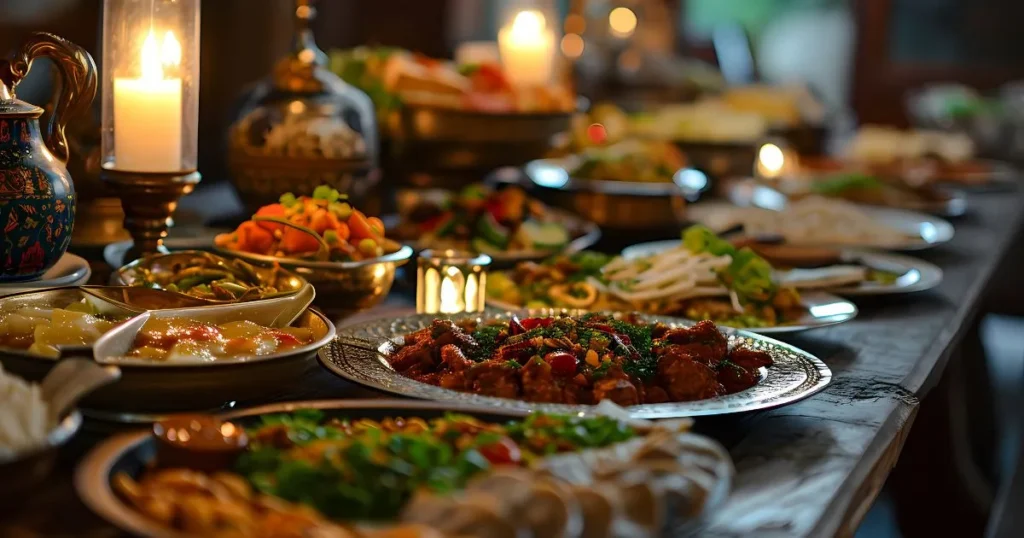
Casablanca presents a fascinating culinary paradox – a modern metropolis where traditional Moroccan regional cuisine adapts to contemporary lifestyles. The city’s restaurant scene reflects its role as Morocco’s economic capital, featuring everything from high-end establishments serving refined Moroccan cuisine to bustling markets where traditional recipes meet modern convenience.
Casablanca’s Unique Food Culture
The city’s coastal location influences its cuisine significantly. Fresh seafood appears in traditional preparations like chermoula (herb and spice marinade) fish, while the port brings international ingredients that local cooks incorporate into traditional recipes. The result is a more cosmopolitan interpretation of Moroccan classics.
Notable Casablanca food experiences include:
- Rick’s Café – Famous for its movie connection and upscale Moroccan-French fusion
- Central Market – Fresh produce, spices, and prepared foods
- Mohammed V Boulevard – street food that displays the city’s diverse cultural mix
- Anfa neighborhood – Modern restaurants reimagining traditional dishes
Contemporary Moroccan Dining
Casablanca’s Moroccan establishments frequently showcase exposed kitchens, contemporary plating, and wine selections – modifications that render traditional dishes approachable for global diners while preserving genuine tastes. Young Moroccan chefs educated in European culinary methods come back to reinvent their grandmothers’ dishes, giving birth to a modern era of Moroccan gastronomy.
Chefchaouen: Mountain Flavors in the Blue Pearl
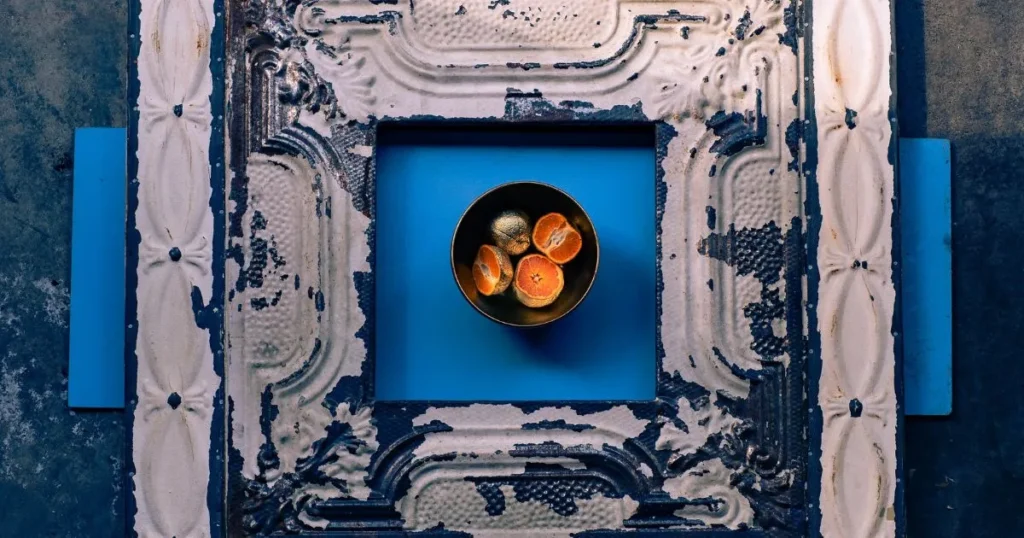
Nestled in the Rif Mountains, Chefchaouen offers a distinct Moroccan regional cuisine influenced by Berber traditions and mountain ingredients. The city’s blue-painted medina creates a magical backdrop for discovering foods that rely heavily on local herbs, goat cheese, and mountain spring water.
Mountain Specialties
Chefchaouen’s cuisine emphasizes fresh, local ingredients unavailable in other regions:
Local Goat Cheese – Fresh and aged varieties appear in various preparations, from simple breakfast spreads to complex tagine ingredients. The mountain goats graze on wild herbs, giving their milk a distinctive flavor that translates into uniquely flavored cheeses.
Wild Herbs and Honey – The surrounding mountains provide abundant wild herbs used both as seasonings and medicinal ingredients. Local honey, produced from wildflower nectar, has a complex flavor profile that enhances both sweet and savory dishes.
Traditional Rif Berber Dishes
- Couscous with seven vegetables – featuring mountain-grown produce
- Harira soup – enriched with local herbs and goat meat
- Mint tea – made with mountain spring water and wild mint
- Amlou – almond butter mixed with honey and argan oil
The city’s small size means most restaurants are family-run establishments where recipes remain closely guarded secrets. Dining here feels like accepting an invitation to someone’s home rather than visiting a commercial establishment.
Tangier: Where Seafood Meets Tradition

Tangier’s location where the Atlantic Ocean meets the Mediterranean Sea generates a distinctive seafood-centered Moroccan regional cooking style. The city’s history as an international zone brought diverse culinary influences that local cooks incorporated into traditional preparations, resulting in a sophisticated coastal cuisine.
Seafood Specialties
Fresh fish arrives daily at Tangier’s port, supplying restaurants with ingredients for dishes that showcase the Mediterranean’s influence on Moroccan cooking:
Grilled Fish with Chermoula – The city’s signature preparation involves marinating fresh catch in a blend of cilantro, parsley, garlic, preserved lemons, and spices before grilling over charcoal. Every restaurant protects its chermoula formulation, producing delicate differences across the city.
Seafood Pastilla – A Tangier innovation that replaces traditional pigeon with fresh seafood, typically combining shrimp, fish, and squid with the classic sweet-savory pastry preparation.
Coastal Dining Experiences
| Location | Specialty | Atmosphere |
|---|---|---|
| Port Area | Fresh daily catch | Casual, authentic |
| Kasbah Restaurants | Refined seafood preparations | Historic, upscale |
| Beach Clubs | Grilled fish, ocean views | Relaxed, modern |
| Medina Cafés | Traditional fish tagines | Traditional, local |
The best seafood experiences in Tangier often involve visiting the fish market in the morning to select your meal, then having it prepared at nearby restaurants – a practice that ensures maximum freshness and allows you to witness the direct connection between sea and table.
The Sahara: Desert Cuisine and Nomadic Traditions
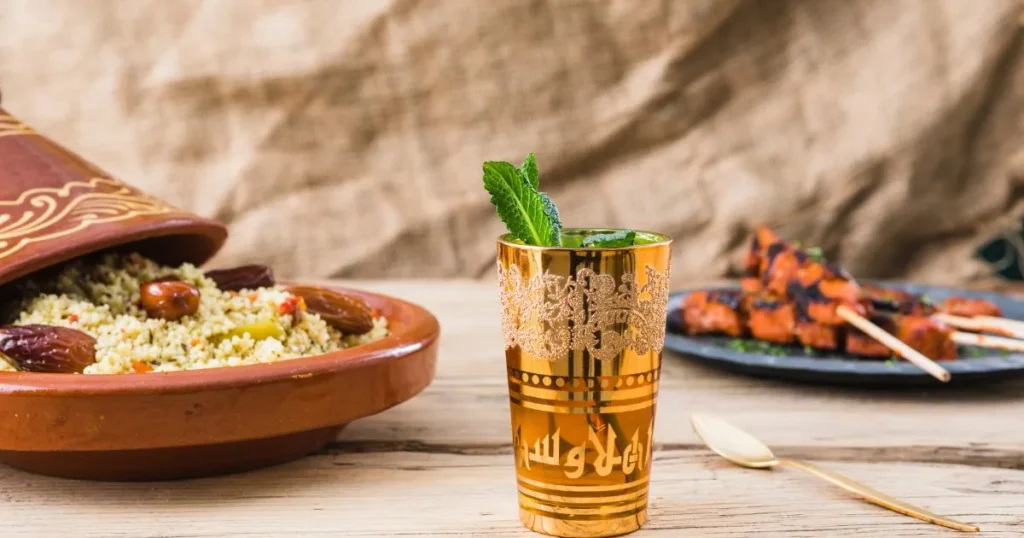
The Sahara Desert region offers perhaps the most unique Moroccan regional cuisine experience, where nomadic traditions meet the constraints and opportunities of desert life. Cooking methods developed over centuries to preserve food, maximize nutrition, and create satisfying meals using limited ingredients and fuel.
Traditional Desert Cooking Methods
Sand Oven Cooking – Berber nomads developed techniques for cooking bread and meat by burying pots in hot sand, using the desert’s natural heat as a slow, even cooking method. This technique produces incredibly tender meats and gives bread a distinctive texture impossible to replicate in conventional ovens.
Preserved Foods – Desert cuisine relies heavily on preserved ingredients that can withstand extreme temperatures and long storage periods:
- Dried dates and fruits
- Preserved meats (khlii)
- Aged cheeses
- Dried herbs and spices
Signature Desert Dishes
Tajine Khodar – A vegetarian tagine featuring preserved vegetables, dates, and desert herbs. This dish showcases how desert cooks maximize limited ingredients to create complex, satisfying flavors.
Camel Meat Preparations – While not common throughout Morocco, camel meat appears in various preparations in desert regions, typically slow-cooked to tenderness and seasoned with traditional spice blends.
Desert Tea Ceremony – The elaborate tea preparation ritual reaches its most refined form in the desert, where the ceremony provides both hospitality and a moment of calm in the harsh environment.
Nomadic Hospitality
“In the desert, sharing meals transcends courtesy – it becomes essential for survival. Every meal offered to a stranger strengthens the bonds that help communities thrive in this challenging environment.” – Mahmoud, Berber guide and traditional cook
Desert cuisine experiences often include participation in meal preparation, from gathering dried wood for fires to learning traditional spice-grinding techniques. These immersive experiences offer understanding of how culinary traditions adjust to environmental obstacles while preserving cultural authenticity.
Planning Your Morocco Food Tour
Best Time for Culinary Travel
Spring (March-May) and autumn (September-November) provide perfect weather for culinary discovery. Markets feature seasonal produce, outdoor dining becomes comfortable, and cooking classes can include garden-to-table experiences.
Essential Experiences by Region
- Marrakech: Street food tour of Jemaa el-Fnaa, traditional riad dinner
- Fes: Cooking class in a traditional house, guided medina food walk
- Casablanca: Modern restaurant experience, central market visit
- Chefchaouen: Mountain herb gathering, family-style dining
- Tangier: Fish market and restaurant combination, seaside dining
- Sahara: Desert camping with traditional cooking, tea ceremony participation
Practical Tips for Food Travelers
Dietary Considerations: Most Moroccan restaurants can accommodate dietary restrictions with advance notice. Vegetarian options are common, and many dishes are naturally gluten-free.
Food Safety: Stick to busy restaurants with high turnover, drink bottled water, and trust your instincts about food freshness.
Cultural Etiquette: Accept tea when offered, eat with your right hand, and don’t rush meals – dining is a social experience in Morocco.
Frequently Asked Questions
Q:Is street food consumption safe during a Morocco food tour? A: Street food from busy vendors with high turnover is generally safe. Look for places where locals eat, avoid pre-prepared foods that have been sitting out, and trust your instincts about cleanliness.
Q: What should vegetarians expect from Moroccan regional cuisine? A: Moroccan cuisine offers excellent vegetarian options. Many tagines are vegetable-based, couscous dishes often feature vegetables, and legume-based dishes are common. However, always confirm that meat-based stocks aren’t used in supposedly vegetarian dishes.
Q: How much should I budget for food experiences in Morocco? A: Budget varies significantly by region and dining style. Street food costs $2-5 per meal, mid-range Moroccan restaurants charge $15-25, while high-end establishments can cost $50+ per person. Cooking classes typically range from $30-80 per person.
Q: Are there food tours available in each region? A: Yes, most major cities offer organized food tours. However, some of the best experiences come from asking locals for recommendations or hiring private guides who can provide more personalized experiences.
Q: What’s the difference between tagines from different regions? A: Regional tagines vary significantly in spice blends, cooking techniques, and ingredients. Marrakech tagines tend to be heartier with more meat, Fes versions are more refined with complex spice layers, coastal areas incorporate seafood, and mountain regions feature local herbs and cheeses.
Q: Should I take a cooking class during my Morocco food tour? A: Absolutely. Cooking classes provide hands-on experience with traditional techniques, insight into ingredient selection, and recipes you can recreate at home. They’re available in most tourist destinations and often include market visits.
A Morocco food tour through these diverse regions reveals how geography, history, and culture combine to create one of the world’s most varied national cuisines. From the bustling food markets of Marrakech to the refined dining rooms of Fes, from Casablanca’s modern interpretations to the desert’s ancient cooking methods, each region offers unique flavors and traditions that contribute to Morocco’s rich culinary tapestry. The journey through Moroccan regional cuisine becomes not just about tasting different foods, but understanding how communities adapt, preserve, and celebrate their heritage through the universal language of cooking and sharing meals.

